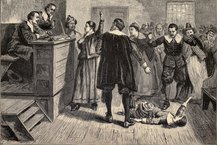The most significant Witch hysteria ever to be seen in America was that of the Salem Witch trials. They occurred in Salem, Massachusetts in 1692 when 19 people were hanged and one person was “pressed to death” on account of Witchcraft. Approximately a further 13 died in jail. In total 185 people were accused of Witchcraft and Salem jail was full to bursting point. By 1711 all were pardoned of their alleged crimes and no convicted Witch was ever executed in America again.
Puritanism and the climate of fear
To understand what happened in 1692, one needs to understand Puritan ideals and way of life.
Puritanism is a Christian religion which started in the 1600s in England. Puritans differed from ordinary Christians in one significant way; they believed that a person’s life was predestined from birth to lead either to salvation or condemnation in Hell after death. Moreover, if one had been condemned to Hell from birth, no amount of goodly deeds would save him or her. Puritans were expected to be devout and faithful in order to ensure their eternal life, but they must always have wondered if they were predestined for Hell’s fire.
In New England, the Puritans ensured they kept close to the state and thus exerted some influence over it and the peoples’ religious welfare. Puritan ideals could have been said to provoke a great deal of fear in God and thus in the Devil also. Such was the desire to be one of the “Elect”, chosen for salvation after death (even though, according to their philosophy you were either elect or you weren’t), the terror of evil would have been great. In the modern mind this might not be easy to imagine, but in 17th Century Puritan New England the Devil would have been a tangible threat, a hideous reality.
Adding to the climate of fear at this time, there had been a smallpox outbreak, a series of military setbacks in Massachusetts, frontier attacks from the French and violent assaults on settlers by the Wabanaki Indians in neighbouring towns. These factors helped to create a rising feeling of anxiety in Salem and other similar towns, the fear centring on God’s punishment for the wicked. In such uneasy times, it is possible to see how imagination and speculation could start to take hold and eventually become a mass hysteria.
Moreover, there must have been very little for young girls to amuse themselves with in the winter of 1692. Salem town was miles away and many of the usual childhood games were forbidden because they were unseemly, or even worse, they allowed the Devil’s idleness to gain the upper hand. Reading and sewing would have been acceptable pastimes but there would have been very little else apart from the usual household chores. Therefore, it is easy to see how the imagination of young girls could be allowed to take flight in the face of desperate boredom.
The case of Tituba, Sarah Good and Sarah Osborne
However, the most popular books young girls read at the time were on subjects such as fortune telling which must have seemed very exciting. It was commonplace for girls to have a circle of friends with whom they would practise divination as a diversion from their tedious existence. A young girl by the name of Betty Parris formed a circle of this sort with her friends only for the occasion to spiral out of control into mass hysteria. Betty and the girls partook in a method of divination whereby an egg is cracked and the white is left to float in a glass of water. The shape of the egg white would symbolise the future. It was on one occasion in January 1692 that Betty claimed she could see the shape of a coffin. Terrified, she had hysterics. Betty was already a sickly child and the fear of death was always around during their harsh winters.
During February Betty continued to have the most terrifying fits and convulsions. Betty’s friends similarly started to display similar symptoms which included loss of different senses such as hearing, speech, memory loss, hallucinations and feelings of being pinched and bitten by spectres. In February 1692, they were examined by a doctor who could find nothing wrong with them physically. However, a recently published book at the time called “Memorable Providences” by Cotton Mather described in detail the symptoms of bewitchment and demonic possession. The doctor pronounced that the girls’ fits must have arisen from Witchcraft. This was readily accepted as a diagnosis.
In order to discover from whence this bewitchment came, a friend of the family, Mary Sibley, told the family’s slave named Tituba to bake a “Witchcake” which was made from rye and the urine of the afflicted and then fed to a dog. If the dog displayed similar symptoms, then the afflicted then bewitchment was beyond question. Dogs and other smaller animals were thought to have often been employed as Witches’ familiars.
Unfortunately for Tituba, this provoked the girls into making accusations of Witchcraft against her. The fact that the girls had enjoyed their initial experiments with divination and Tituba’s stories did not stop them from making this very serious accusation. It is also ironic that Mary Sibley had instigated the Witchcake episode which in itself must have been a form of sorcery, yet she was never accused. Tituba, being but a poor slave, was a vulnerable scapegoat.
Two other Salem scapegoats were accused at the same time and on the 1st March two magistrates - John Hathorne and Jonathan Corwin - started cross-questioning three women; Tituba, Sarah Osborne and Sarah Good – the latter two being eccentric social outcasts neither of whom attended Church.
The girls were now having frequent fits and convulsions which they demonstrated with great aplomb at Ingersoll’s Tavern, the place where the three women were examined. They claimed that the spectres of the women were appearing to them and torturing them by biting and pinching. That no one else could see the spectral “evidence” did not concern the assembled. Many people had come to watch and some of them came forward to say their milk had gone sour or that a cow had become sick which was further evidence of Witchcraft.
It was clear the magistrates already believed the women were guilty and asked the same three questions to each; “Are you a Witch?”, “Have you seen the Devil?” and “How do you explain the afflictions of these girls?”
Tituba initially claimed she was innocent, but for some never-discovered reason she then confessed that she, Osborne and Good had entered into a pact with the Devil. Moreover, she said that a tall, dark man had approached her and asked her to sign his book. This man was of course the Devil and he occasionally appeared to her in animal forms. Her confession lasted three days.
All three women were imprisoned in the county jail pending trial. Ultimately, Sarah Good was hanged for her alleged crimes; Sarah Osborne died in jail but Tituba survived because she had confessed. The few who did confess to being Witches escaped the gallows for their “honesty”.
Guilty until proven innocent
Over the summer months, hundreds of people were accused and the prisons were full to bursting point. The Governor of Massachusetts at the time, Sir William Phips, returned to Boston in 1692 after being in his native England to find jails full to bursting point and that Salem was in chaos.
Then the “touch test” was introduced. If any of the accusers could be temporarily cured of their writhings and groanings from the touch of an accused person, then this was also entirely legitimate, if not damning evidence, of Witchcraft. This method was tried in a number of the trials and inevitably the girls immediately desisted their fits upon being touched.
The accused had no form of defence counsel, could have no witnesses to support them and had to rely solely on their own verbal skills of defence. Given that the people arrested tended to be poor or of little influence they often lacked the wit, speed of thought and eloquence so necessary for defence in any courtroom.
The turnaround
By the autumn of 1692, the Witch-hunt began to lose momentum. The deaths of many more men and women as a result of dubious claims started to worry the citizens of Salem who were becoming more and more concerned about the authenticity of these “Witches”. Spectral evidence was now doubted by many. Perhaps many of the people knew that the accusations were falsehood but dared not speak out until this point.
By October most knew that innocent lives had been lost. The educated people of the Town urged members of the court to exclude spectral evidence as unreliable, not to mention the nonsensical touch test. A new court was formed to deal with the prisoners and it was ordered that they should be protected. There were further trials but no further deaths – all remaining prisoners were finally released on 9th May 1693.
After the release of so many people and the crisis ebbing away, it was as though the clouds had parted and the light of truth showed with terrible clarity what had really taken place. It had been no more or less than a delusion and not one of the dead could have reasonably been called a Witch. There had been no Witches in Salem. If Satan had wished to cause trouble in that part of New England, the pious, good ministers and judges had already done the work for him. The only evil was the evil they had created within their own community.
We have selected the most relevant psychics for this article, you can connect with any of them and get accurate advice on this subject.









